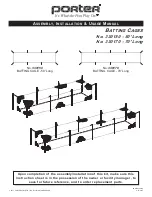
3
8
1/4" tapped holes
for rope cleats
9
1
3
4
5
6
7
2
6
7
Detail "A"
1.
Check all parts against Parts List on Page 2 to make sure all have been included.
2.
Begin by assembling uprights. At top end, insert eye-bolt (6) into hole thru upright
(1). Secure with 5/16" locknut (7). Note - the eye must be in the horizontal position.
Tighten the locknut after rotating the eye-bolt. See Detail “A”.
3.
Assemble pulley (4) and s-hook (5) to eye-bolt assembly (6) from Step No. 2.
Crimp both ends of s-hook completely closed, to prevent removal of pulley. See
Detail “A”.
4.
Install end cap (2) onto top end of upright (1). See Detail “A”.
5.
Each upright (1) has one set of tapped holes on one side of the upright. A rope cleat
(7) is assembled to each upright at these tapped holes, with 1/4" x 1-1/2" lg. flat head
machine screws (9). See Detail “A”.
If batting cage uprights are being used with outdoor ground sleeves or indoor floor
sleeves, follow the installation instructions provided with the sleeves. If batting
cage uprights are being installed permanently into concrete footings, proceed to
Step No. 6 below.
6.
Locate and dig footings for each upright. CAUTION – Contact your local utility
companies to locate buried electrical, gas and water lines before digging holes for
footings. Also, check for overhead utilities. See Detail “B” for footing details, and
Detail “D” for footing locations.
TOP OF FOOTING AT POLE
MUST BE AT LEAST
1
2
"
ABOVE PLAYING SURFACE
FOR PROPER DRAINAGE
CAUTION - CHECK
FOR LOCATIONS OF
BURIED POWER
CABLES, DRAIN
TILES, WATER LINES,
ETC. BEFORE
DIGGING HOLES FOR
FOOTINGS
SLOPE TOP OF
CONCRETE FOOTING
APPROXIMATELY 3"
BELOW GRADE FOR
PROPER DRAINAGE
FOOTING
DETAIL
1'-6"
DIA.
2'
-6
"
1
2
"
3"
Detail "B"
2'-
0
"
The footer size is to be determined by the
architect/engineer and is based on local
codes and soil conditions.























